Have you heard that heel striking is bad?
Like most runners, you’ve probably wondered if heel striking is bad for you. After all, it seems like it would hurt your shins and knees to land on them with such force. But as the opposite is true: Landing on your heels can actually help you run faster according to an extensive study conducted by Dr. Benno Nigg at the University of Calgary. Because running with a heel-first stride puts less stress on the lower joints than landing flat-footed or with a forefoot strike does.
Then why have you been told by coaches, colleagues, and friends that you should be switching to a more forefoot or midfoot strike?
Here, we will clear the air.
What does different foot striking look like?
We did a post about this on social media recently, so we will link it here to see the different foot strikes (heel strik, midfoot strike, and forefoot strike, compared).
Where did this debate start?
Even though 95 percent of runners instinctively strike the ground with their heels, there is a growing trend among running experts to have lifelong heel strikers convert to a more forward contact point.
Striking the ground with our forefoot, instead of our heel, is supposed to reduce impact loads and enhance the storage and return of energy in our tendons (supposedly making us faster and more efficient).
Today, more and more trainers are encouraging runners to adopt a mid- or forefoot strike pattern. The rationale behind this shift is that lowering your centre of mass, and reducing impact forces, will make you faster and more efficient. The shift from heel-to-toe contact can decrease impact loads by enhancing shock absorption, and increasing the storage and return of energy in our tendons…. or so we thought.
Force signatures
I think the whole heel strike being “bad” came about with running research that showed that there was an initial blip (see the initial peaks in force between 0 and 20-30ms) on the force plate in running studies. To orient you to the following graphs, the 0 time point is initial contact with the ground, the peak of the curves come when the entire body weight is on the ground/force plate, and the forces return to zero on the right hand side of the graphs when the individual toes off. These initial studies showed that there were greater INITIAL but not TOTAL forces in a running stride.
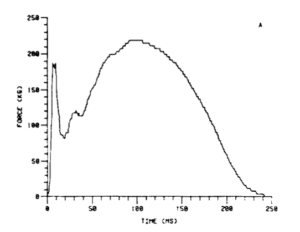
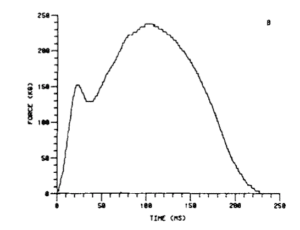
Graphs like these from Dickinson et al (1985) started to outline the force plate data from bareboot (A) versus shod (B) running. The initial steep “blip” in graph A was concerning for some, as it showed a faster and higher initial rate of force development. Compared to shod running, barefoot running must be worse for creating injuries then right? Especially over the thousands of cumulative steps runners take over the course of their workouts?
Interestingly, in the same research paper, when they compared the force plate data of a mid foot striking pattern while barefoot (left) to a mid foot striking pattern shod (right/B), the initial ground reaction “blip” was gone for both instances, but looked very similar to each other.
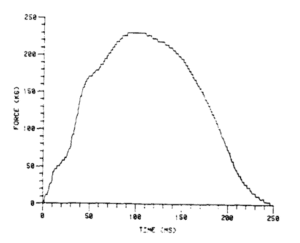
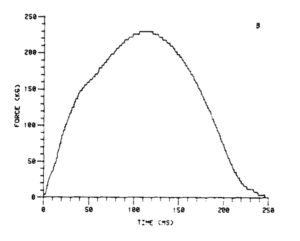
So while the total forces (height of each peak in all four graphs) are approximately the same, the difference between mid foot and rear foot striking likely started to get attention for these types of reasons.
But the debate isn’t over just yet.
As running speeds increase, there is a slight increase in the vertical ground reaction forces. Despite this, the overall increase in ground reaction forces for a given speed, with different foot landings, is not seen (Hamill et al, 1983). This might mean there are less differences between foot contacts as originally thought, and even if there were, it is not great evidence of one being injury-preventative over the other. In fact, it’s not evidence for this at all.
So what we think – is that maybe this is where the debates about HEEL strike versus MIDFOOT strike versus FOREFOOT strike came about…. in the noticing of small differences in initial ground contact differences on force curves/signatures for running. OR maybe the debates just started when the book Born to Run came out (a laymans read about why humans are made to run).
Either way – people started to panic about heel striking….. for no reason. Although appealing, the belief that switching to a mid or forefoot contact point will alter injury rates and improve efficiency has never been proven. Research evaluating injury rates associated with different contact points in more than 1600 runners has shown no difference in the incidence of running-related injuries between rearfoot and forefoot strikers (Kleindienst et al, 2007; Kleindienst et al, 2003; Walther, 2005).
Research evaluating the metabolic cost of running reveals that running with a heel-first strike pattern does not always offer an advantage. In fact, most studies suggest the vast majority of recreational runners are significantly more efficient with a midfoot strike pattern (Cunningham et al, 2010). The results of this study confirm that walking with a midfoot strike pattern reduced the metabolic cost of walking by a surprising 53 percent. That’s a huge difference in efficiency and it explains why almost all slow joggers (who often run just a little faster than walking pace) make initial ground contact with their toes.
There are times when a heel strike is better?
At what speed does a midfoot contact lose its metabolic advantage?
In a computer-simulated study evaluating efficiency, University of Massachusetts researchers showed that while running at 7:36 per mile pace (4:43min/km), heel-striking was 6 percent more efficient than mid or forefoot striking. It has been confirmed in recent studies that the 6:25 per mile pace (3:59 min/km) is the transition point at which there is no difference in economy between heel and midfoot strike patterns. These studies confirm that although highly skilled runners are efficient while landing on their mid or forefeet, the majority of recreational runners are more efficient with a heel-first strike pattern.
Heel striking is the natural gait when going slow, so in walking we would almost always expect a heel strike. When running, where the foot lands in relation to our hip/centre of mass will impact our tendency for a forefoot (underneath the centre of mass) or more heel strike (further from centre of mass). When running faster, naturally we will tend to strike under our body compared to slower running where we tend to adopt a pattern that is between walking and running. Shoes can also impact this as a large heel drop or heel-cushioned shoe can force one to impact the heel earlier than normally seen in barefoot running, for example.
When running as fast as possible, the heel still tends to touch down, but after an initial forefoot or midfoot strike. Most recreational runners are honestly very slow and so a heel strike pattern is likely just the result of their pace, and is totally normal.
What about Injury prevention?
In terms of preventing injury, is there one way of running that is better than the others?
“Runners who strike the ground with their forefoot absorb more force at the ankle and less at the knee; mid- and forefoot strikers absorb the force in their arches and calves, while heel strikers absorb more force with their knees” (Michaud, 2014).
Per the summary by Michaud (2014), the reason that runners with heel versus mid/forefoot strike patterns get different injuries is because they absorb force in different areas. At Vital, we coach a lot of runners of different abilities, from recreational joggers, to elite ultramarathoners, and sprinters (bobsleigh and skeleton athletes, primarily). One thing we have found all runners have in common in terms of injuries is that:
- Their volume increases suddenly, above normal loads, and tissues aren’t ready to handle that load
- They are running in a way that increases the stress on one part of the body over another
- They switch gear (new insoles or shoes or barefoot) and forget to make the transition slow.
All injuries are caused when the stress on the tissue is greater that the tissue’s ability to withstand that stress, so whether the breakdown occurs slowly (disc degeneration, chronic tendinosus), or quickly (muscle tear, tendon rupture, bone break), depends on the circumstance and the load.
“But do elite athletes ever heel strike? I thought they only used forefoot strike, which is why I wanted to switch, too?”
Heel striking isn’t inherently bad or wrong. Here’s an elite runner not accelerating, but going at an easy but constant pace, and he is still heel striking:
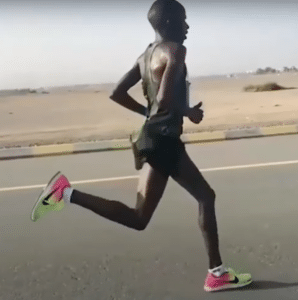
Retrieved from:
https://www.youtube.com/watch?v=Y1pxFi1NBok&t=19s
In sprints or faster accelerations in running, this is probably one of the times we naturally don’t see a heel strike because the shin angle is angled so far forward. Again, not inherently better than heel striking, just faster running:
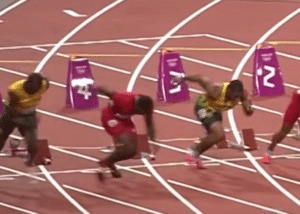
Retrieved from:
https://www.youtube.com/watch?v=2O7K-8G2nwU
In sprinters, during maximal speeds, we see less heel strike (more of a forefoot strike), but then the heel still hits the ground often later in the stance:
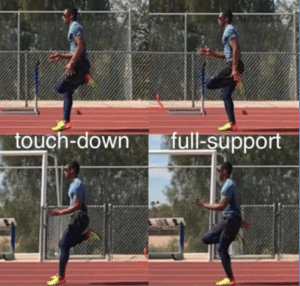
Retrieved from Mcmillan, S., & Pfaff, D. (2018). The ALTIS Kinogram Method. 1–36.
Key points you can take away for your own running
The bottom line is that before you consider switching from a heel to a midfoot strike, make sure that it’s clinically justified and appropriate for your current running speed, injury history, and running style. Since a midfoot strike pattern significantly reduce stress on the knee, that style could be considered for runners suffering with recurrent knee pain. Similarly, a heel striking foot pattern reduces stress at the foot, so for those currently battling foot pains and injuries (history of Achilles, forefoot, and/or plantar fascial injuries), this running style might be tried for them – ALWAYS in conjunction with proper therapy, strength training, and running volume progression. Contrary to what many running experts say, striking the ground heel first is safe and efficient. The ninety-five percent of runners who naturally select a heel-first strike pattern can’t all be wrong.
In summary
- Don’t change your gait just because, seek a professional opinion if you’re injured and trying to get out of that loop. After a gait analysis we can better determine if we think there’s more going on that could help rather than just switching the stride right away.
- There could be some value to switching to a more forefoot gait if there are injuries related to excessive breaking during running. Typically we see this in recurring hamstring and calf injuries.
- Switching away from heel striking just because, can cause more stress on the calves, so if you need to switch for some reason, do so slowly and progressively.
- Seek expert advice before reading a book or two and thinking you should switch your running gait
- Shoes are typically built with big heel lifts these days (drop % measures this difference from front to back of shoe) so starting with slightly lowering the aggressive drop could be a lot of change in itself. Most sites will show a % drop next to more information about the shoe, so look for lower %’s on your next running shoe purchase. Don’t go straight to “zero drop” shoes if you are used to heel striking.
- If you’re battling injuries, remember that they are multi-factorial and not just a result of your mid foot versus forefoot strike or your running cadence.
- If you don’t know how to strengthen your feet (something that can be very beneficial for acute AND chronic injuries), check out our Foot Foundations Program.
The main discussion around this topic seems to concentrate specifically on the question about differences between barefoot and shod running or heel and forefoot striking and the question of ‘which is better’.
We suggest that this may be the wrong question to be discussed. We suggest that the important aspects of performance and/or injuries are more related to (a) individual preference and (b) individual running style, independent on whether the athlete runs in shoes or barefoot, forefoot, midfoot, or heel strikes.
Landing on the heel produces about the same internal forces for running barefoot or running in shoes. The take-off forces are about the same for running with shoes or running barefoot!
References
Bergmann, G., Kniggendorf, H., Graichen, F., & Rohlmann, A. (1995). Influence of Shoes and Heel Strike on the Loading of the Hip Joint. J. Biomechanics, 28(7), 817–827.
Cunningham C, Schilling N, Anders C et al. (2010). The influence of foot posture on the cost of transport in humans. J Experimental Biology;213:790-797.7.
Daoud A, Geissler G, Wang F, Saretsky J, Daoud Y, Lieberman D. (2012) Foot strike and injury rates in endurance runners: a retrospective study. Med Sci Sports Exerc, Jul;44(7):1325-34.5.
Delgado T, Kubera-Shelton E, Robb R, et al. (2013). Effects of foot strike on low back posture, shock attenuation, and comfort in running. Med Sci Sports Exerc, 4:490-6.11. Goss D,
Ferber, R., Davis, I. M. C., & Williams, D. S. (2003). Gender differences in lower extremity mechanics during running. Clinical Biomechanics, 18(4), 350–357. https://doi.org/10.1016/S0268-0033(03)00025-1
Fukuchi, R. K., Stefanyshyn, D. J., Stirling, L., Duarte, M., & Ferber, R. (2014). Flexibility, muscle strength and running biomechanical adaptations in older runners. Clinical Biomechanics, 29(3), 304–310. https://doi.org/10.1016/j.clinbiomech.2013.12.007
Haruhiko, G., & Suguru, T. (2022). Foot strike patterns and running-related injuries among high school runners: a retrospective study. Journal of Sports Med Phys Fitness.
Hamill J, Allison H. Derrick G, et al. Lower extremity joint stiffness characteristics during running with dif-ferent footfall patterns. European J Sports Sci. Oct 15, 2012.6.
Hesegawa H, Yamauchi T, Kraemer W. Foot strike patterns of runners at the 15-km point during an elitelevel half marathon. J Strength Cond. 2007;21:888-893.8.
Kleindienst F, Campe S, Graf E, et al. Diff erences between fore- and rearfoot strike running patterns based on kinetics and kine matics. XXV ISBS Symposium 2007, Ouro Preto, Brazil.2. Kleindienst, F.I. (2003). Gradierung funktioneller Sportschuhparameter am Laufschuh. Shaker. Aachen, 234-235.3.
Lewek M, Yu B, et al. Accuracy of self-reported foot strike patterns and loading rates associated with traditional and minimalist running shoes. Human Movement Science Research Symposium, 2012, The Uni-versity of North Carolina at Chapel Hill. Highlight
Lieberman, D. E., Venkadesan, M., Werbel, W. A., Daoud, A. I., Dandrea, S., Davis, I. S., Mangeni, R. O., & Pitsiladis, Y. (2010). Foot strike patterns and collision forces in habitually barefoot versus shod runners. Nature, 463(7280), 531–535. https://doi.org/10.1038/nature08723
Mcmillan, S., & Pfaff, D. (2018). The ALTIS Kinogram Method. 1–36.
Michaud, T. C. (2014). Is It Harmful To Heel Strike When Running? by Competitor Magazine.
Miller R, Russell E, Gruber A, et al. Foot-strike pattern selection to minimize muscle energy expenditure during running: a computer simulation study. Annual meeting of American Society of Biomechanics in State College, PA, 2009.9.
Napier, C., Fridman, L., Blazey, P., Tran, N., Michie, T. v., & Schneeberg, A. (2022). Differences in Peak Impact Accelerations Among Foot Strike Patterns in Recreational Runners. Frontiers in Sports and Active Living, 4. https://doi.org/10.3389/fspor.2022.802019
Nigg, B., & Enders, H. (2013). Barefoot running – some critical considerations. Footwear Science, 5(1), 1–7. https://doi.org/10.1080/19424280.2013.766649
Nigg, B., Hintzen, S., & Ferber, R. (2006). Effect of an unstable shoe construction on lower extremity gait characteristics. Clinical Biomechanics, 21(1), 82–88. https://doi.org/10.1016/j.clinbiomech.2005.08.013
Ogueta-Alday A, Rodríguez-Marroyo JA, García-López J. Rearfoot Striking Runners Are More Economical than Midfoot Strikers. Med Sci Sports Exerc. 2013 Aug 30. [Epub ahead of print]10.
Walther, M. (2005). Vorfußlaufen schützt nicht vor Überlastungsproblemen. Orthopädieschuhtechnik, 6, 34.4.

